PROLOGUE
I was 12 years old when the radio announced that the Allies had
launched the long-awaited invasion of Europe that would ultimately
lead to victory and the end of World War II. That day was June 6, 1944
and would come to be known as D-Day.
Last June was the 60th anniversary of that historic event.
I beg your indulgence as I begin the story, about one of the greatest
assignments of my long career as a newspaper photographer.
D-DAY REVISITED
By Dick Kraus
Newsday
Staff Photographer (retired)
CHAPTER
SIX
Once again, I twisted and turned in the cramped airline seat as
Jim Kindall and I returned to Normandy. This time, instead
of starting our story in Germany, we flew right to France.
We landed at Charles DeGaulle Airport in the early morning and
grabbed a cab to take us into Paris. Our first stop was the
Associated Press office there. I was to have my Leaf Transmitter
upgraded to enable it to interface with the French telephone
system so that I could transmit my photos directly back to
Newsday on Long Island. Even though there were still two weeks
to go before the big June 6th D-Day Anniversary celebration,
there was a tremendous amount of energy in that AP office as
everyone geared up for the event. I was just one of many photographers
who were trying to get AP’s help.
When the conversion was accomplished, Kindall and I took a cab
to the railroad station where we boarded a high-speed train to
Caen, Normandy. It was another beautiful trip through the French
countryside. Now it was early summer and everything was green,
unlike the bleak winter landscape we had experienced on our first
trip here the previous November.
We arrived in Caen in the early evening. This time we had made
reservations for a rented car. By now we knew our way around the
city and had no trouble getting to the Hotel Courtonne. And, they
did have a couple of rooms reserved for us.
The next morning we drove to the headquarters at the American Cemetery
overlooking Omaha Beach. That is where the White House Press Office
would be setting up and where we would get our ever so vital press
credentials. A large press tent had been erected and there were
U.S. Army liaison officers in residence. We checked in with them,
and inquired as to the status of our credentials. A major made
a phone call and informed us that the good news was that there
were White House Press credentials for us. The bad news was that
they were in the hands of the White House Press Officer who was
traveling through Italy and England with the President and wouldn’t
be available to us until they arrived in Normandy. And that wouldn’t
happen until June 5th, the day before the big event. So, for the
next two weeks we would have to depend upon our New York City Police-
issued press cards and hope that they would suffice.
We were expected to come up with daily stories for the paper for
the next couple of weeks. We were to report on preparations for
the anniversary and do stories about the WW II veterans that were
pouring in to Normandy for the occasion.
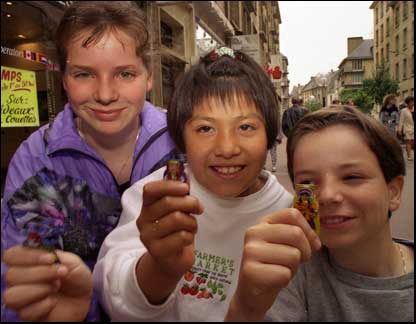
French school children hold
up souvenir noisemakers called "crickets" for the sound
they make. These were used by U.S. Paratroopers to identify
one another as they assembled in the dark after landing
on the morning of D-Day.
©Newsday Photo by Dick Kraus |
|
The days flew by in a blur as we ranged up and down Normandy looking for our
stories. One of the things that Kindall and I both wanted desperately to
report on was how these old veterans of D-Day would react to being back
where they fought and where they saw their buddies die. Each day there
were more and more of these old soldiers arriving. Kindall wrote and I
photographed but the emotion that we were looking for just didn’t
seem to be present. Probably because many of these earlier arriving veterans
hadn’t landed on the beaches on the first day. They had come ashore
days or weeks after D-Day and weren’t involved in the initial carnage.
|
| We did the best
that we could, but Kindall didn’t want to submit any
of these early attempts. He and I both felt that we stood
a better chance of getting a good story as more old timers
started arriving. In the meantime, we shot the arrangements
being made by the French. Signs and posters were appearing
all over Normandy, welcoming the Allied soldiers and the
other attendees. There were shops and stores springing up
all over the Normandy beaches that were dedicated to selling
memorabilia of D-Day. Maps, books, photo albums, scarves
and tee shirts, model planes, tanks and ships, commemorative
plates and glasses were offered up as remembrances. |
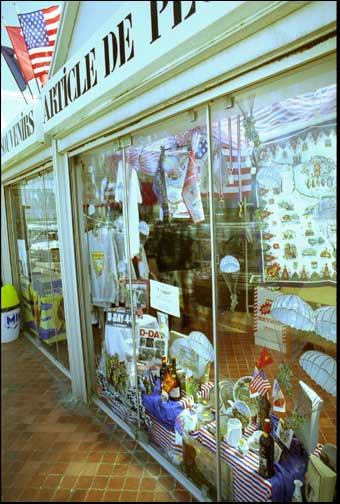
D-Day souvenirs for sale
on the invasion beaches in Normandy.
©Newsday Photo by Dick Kraus
|
|

A souvenir stand at Omaha
Beach.
©Newsday Photo by Dick
Kraus
|
|
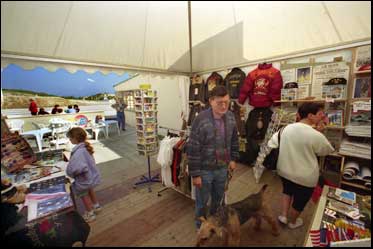
A souvenir stand at Utah
Beach.
©Newsday Photo by Dick Kraus
|
|
The
French are a strange people. Several months ago, on our first
trip here, Kindall and I had a difficult time getting cooperation
from them. There was a very distinct animosity towards Americans
in evidence. They showed little inclination toward trying to
speak English. Nor did they try to understand my attempts in French.
Granted, my command of the French language is pretty bad. But,
at least I tried to use their language. No one seemed willing
to
make any effort to meet me halfway.
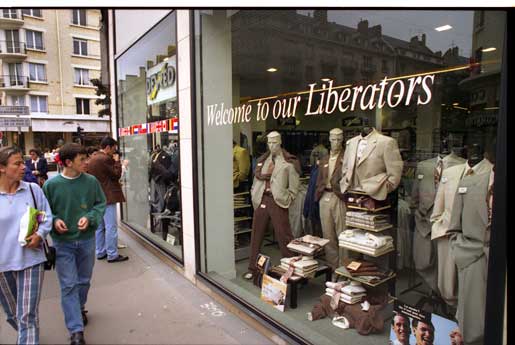
Signs in English
adorn shop windows welcoming "our Liberators."
©Newsday Photo by Dick Kraus |
|
Now,
suddenly, my lousy French was getting me responses. And,
many times the response was in English. What happened in
the intervening months? Did my French suddenly improve? Did
the locals suddenly learn to speak English?
I believe the answer was that the French government reminded its citizens that
there would be a mob of Americans coming to France with a lot of money to spend.
It kind of behooved the populous to extend some basic courtesies to us foreigners.
I don’t mean to sound jingoistic but it seemed to me that the French never
forgave the U.S. for becoming a major power in the world, while their own prestige
kept sinking lower and lower.
|
Late one
night; or I should say, early one morning, Jim Kindall and I
had completed an extremely long day. By the time we
returned to Caen and our hotel and finished filing copy
and transmitting
photos, it was around 2 a.m.. Neither of us had eaten any food
since breakfast and we were famished. There would have
been no trouble
finding a place to eat since most European restaurants open
late and stay open much later than our American eateries.
But, the two
of us were really dragging ass and had a full schedule ahead
of us that day. So, we opted to grab something simple right
near the
hotel. Across the street was a creperie. Here, they served
crepes, which are very thin pancakes that can be filled
with cheese or
fruit. The weather was very mild so we took an outdoor table
in a section that was separated from the rest of the sidewalk
by a
row of potted hedges.
Jim and I chatted about our stories while we waited for our crepes
to arrive. I saw the battered and bloody drunk approach us
from the street. He wore torn clothes and had dried blood crusted
across
one side of his face that had come from a gash over his left
eyebrow. He staggered over to us, separated by the hedge.
“
Allez! Allez!” I told him. “Go away! Go away!” France
was suffering from tremendous unemployment and we were constantly
besieged by panhandlers with their hands out. I was tired,
hungry and cranky and in no mood for this. The man stood there,
swaying
on unsteady legs. He was saying something and I tried not
to pay any attention to him. But, then I realized that he was
speaking in heavily accented English.
“
Sirs,” he was saying, “Forgive my intrusion and my
appearance. I am a French merchant marine sailor and I am very
drunk
and I have just been in a fight. But, I wanted to thank you Americans
for rescuing my country from the Nazis. If it weren’t
for you, I wouldn’t be here today.” And then
he staggered off into the night before either of us could
say anything.
We sat there for several minutes, allowing what this Frenchman
had just said to sink in. I sat with my jaw agape, mortified
about my attitude of a few moments ago. My God. This Frenchman
had just
thanked us for rescuing his country and I had told him to
beat it. In spite of my efforts not to, I had become The Ugly
American.
I was chagrined.
"He was wrong about him not being here if not for America’s
intervention,” I told Jim. “He would be here, but he
would have been speaking German.” I needed to break the
mood, I guess.
| Every
morning, we would stop at the press tent at the cemetery
to check
on our credentials. Then we would scour the grounds, looking
for a veteran kneeling at the grave of a fallen buddy. Finding
nothing that was any better than what we already had, we
would then travel up and down the coast, checking other battle
sites. |
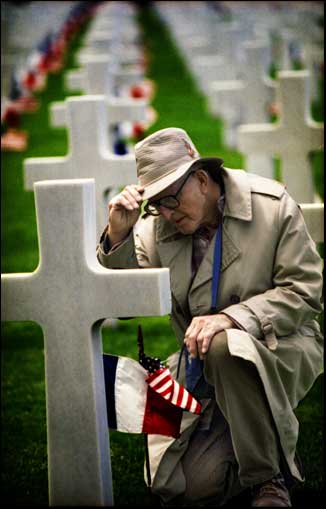
Days later I was able to
get this shot. I still felt that I should have done
better.
©Newsday Photo by Dick Kraus
|
|
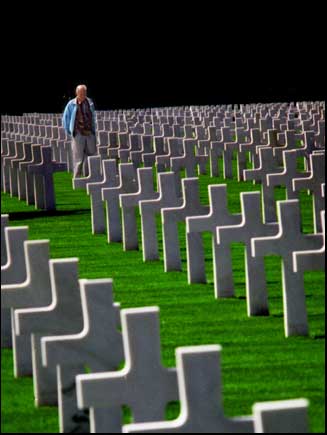
A solitary American
Veteran wanders through the American Cemetery in
Normandy, looking for names.
©Newsday Photo by Dick Kraus |
|
|
We would return to the
Hotel Courtonne late each night and I would rush my film over to
the Fuji shop where I had made arrangements with the lovely Marievann,
the owner. I would leave my color negative film to be developed,
without prints. Then Jim and I would find a restaurant where we would
enjoy dinner. I would stop at the Fuji shop to pick up my film and
then return to our rooms where Jim would type up his story on his
laptop computer to be e-mailed back to his desk. I would go over
my negatives with a loupe and would select several frames that I
felt would be relevant to Jim’s story.
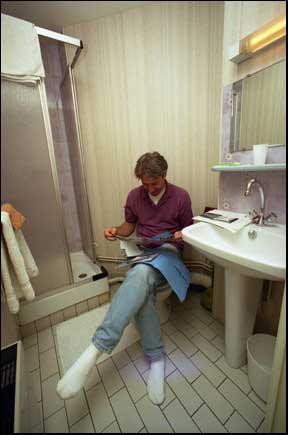
Jim Kindall finds a quiet
spot in his hotel bathroom to go over his notes before
writing his daily story.
©Photo by Dick Kraus
|
|

My nightly routine; hunched
over the Leaf Scanner on my hotel bed, transmitting
daily pictures back to Newsday.
©Photo by Jim Kindall
|
|
Hunched
over the Leaf Scanner, I would crop and make adjustments to my
shots and then add captions. I would then
call the special
number back at Newsday and speak to a technician who would
plug me in to the computer there. I was using an old model
Leaf and
had to transmit each photo separately. But, since it was
such
a convoluted system just phoning back to the office, I
would tell
the technician that I had four or five shots to transmit.
Rather than break the connection each time, we would hook up
the computer
and Leaf scanner and I would transmit the first shot. It
took almost a half hour for each picture so the tekkie would
leave
the connection
open and would proceed to go about his other duties, returning
only when the allotted time was up. If he heard silence
when he picked up the phone, he knew that the transmissions were
over and
he would throw the switch enabling him to talk with me.
If
all went well, he would check each transmitted photo and
inform me
if they looked good. Sometimes there might have been a
line break causing a missing section of the photo and I would
have
to resend
it. More often than not, the signal would be broken during
the first transmission and nothing at all would be received
at the
other end. There was nothing I could do but wait until
the tekkie returned to check the system. Which meant that several
hours
were wasted and I had to start all over again. Often I
would
crawl into
bed after one of these long and infuriating sessions, only
to be jangled awake by the alarm after an hour of sleep.
And, we
would
be off to start another quest.
As the D-Day anniversary approached, more and more veterans were
arriving and Jim and I knew that we would find the story
and the photo that we knew would sum up this whole experience.
On this
particular day, the sun was bright and the green grass
covering the American graves seemed even more vibrant than ever.
Still,
the morning passed without anything of substance. There
was something going on up the coast that we wanted to check out,
so
we left
and drove the 40 miles to do that story. But, we felt that
today was
the day we would get what we had been searching for. Jim
made a phone call back to his editor to let him know what we
were
doing.
He was told that the managing editor had been looking for
him and he was switched to the ME’s line. Howie Schneider
told Kindall that a group of American schoolgirls from a Long
Island academy
were touring the Normandy battlefields and Newsday wanted
a front page story using that local hook. Of course, neither
he nor anyone
else had a clue as to the whereabouts of the girls. Nor
was he at all interested when Jim told him of our quest for
the elusive
emotional veteran. “Go find those Long Island kids
before today’s deadline!” were our orders.
Jim Kindall was an exceptional reporter and he pulled out every
trick of the trade. He made call after call. We had no cell
phones in those days, so he had to use French pay phones. He
called the
American Embassy. He called any number of French charter
bus companies. He finally got through to the school on Long Island
and was told
that sometime that afternoon the students would be visiting
the American Cemetery from whence we had just come.
We jumped into our rented car and sped through the narrow winding
Norman roads, back to the cemetery. It was late in the afternoon
when we got there and many of the tour busses had already
left the parking lot. We ran through the remaining ones, asking
if any
were there for these American schoolgirls. A woman stepped
forward, telling us that she was one of the chaperones for the
group. Thank
God. If we had missed them there, who knows how or if we
would have ever caught up with them. We were told that the girls
were
being rounded up, as we spoke, to head to another of the
D-Day landing sites.
“
No, no!!” I shouted. The ME had specifically said that
he wanted a shot of the girls in the cemetery. I ran through
the gates
and spotted a large group of young women in the uniform
of their academy, heading for the gate. I quickly identified
myself
and
asked them to wander through a section of nearby graves.
I was able to bang off several quick frames before the girls
were
shepherded
onto the bus.
Whew. Now I wanted to continue our search for the elusive old
soldier, but Kindall said that he didn’t have enough material for
his story about the girls. He wanted to ride in the bus so that
he could interview some of them. I had to drive the rental car
and follow them to their next stop. I never did get a chance to
photograph that emotional vet. But, I did make page one of the
next day’s Newsday with the girls in the American
Cemetery.
The Airborne
GI’s had played a major role in the D-Day
invasion. They had parachuted into enemy held Normandy
in the early morning
dark. They had also landed behind enemy lines in flimsy
gliders and had suffered tremendous casualties. Many books
and films
recounted the valor of those brave men.
To commemorate these events, a huge multi-national parachute exercise
was scheduled to take place in a large meadow outside
of the village of St. Mère Eglise. The Army Press Liaison officers
in the press
tent kept everyone informed of all the happenings regarding
the D-Day anniversary. One of these officers was particularly
helpful
to Kindall and me. He was the one we kept bugging about
our press credentials. He warned us that the drop zone was
expected
to
be particularly muddy. Not just, “Oh my gosh.
My shoes are getting dirty,” muddy. It would,
deep, sucking, thick sloppy like you couldn’t
believe muddy. “People would be losing
their shoes in this muck,” he told us. “Get
boots,” we
were warned. I bought a pair of boots during one of
our excursions through the countryside.
The morning of the big drop, Jim and I left before dawn to avoid
the crowds that would be drawn to this spectacle. We
had been directed to park in the village where there would
be busses
to take the
press to the drop zone. We filed off the bus into the
mud. It was exactly as we had been told; deep, sucking, thick,
sloppy mud. Some
of the glamorous TV standup reporters who had distained any suggestion
of wearing ugly boots over their Gucci pumps were reluctant to
get out of the busses. As we walked along the edges of the field,
many newsmen and women did, indeed, lose their shoes to the sucking
muck. Some clever souls had brought large sheets of cardboard cut
from cartons and they stood on those. Unfortunately, they couldn’t
claim those havens from the slime for themselves alone
and soon there was a crowd of humanity seeking relief
on each of
them.
I, on the other hand, strode bravely through the ankle deep mud, shod in my newly
acquired French rubber boots. This enabled me to take positions otherwise
denied most of the rest of the newspukes who weren’t as well advised
as I. However, to the credit of some, the more dedicated removed their shoes
and socks, rolled up their pants and waded into the goop. Bravo! |

| While a TV reporter next
to me tries to keep his sneakers dry by standing on
a folded step-stool, I am standing in the wet and muddy
field in my boucage boots. (Boucage is French
for meadow, I believe.) |
|
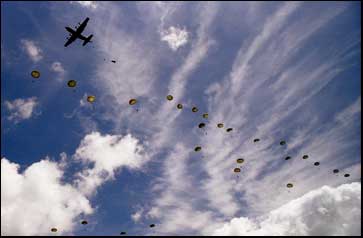
Heralded by the
thunder of many large planes overhead, paratroopers
fill the sky.
© Newsday Photo by Dick Kraus
|
|
Soon the sound of many planes reached us and we looked up to see hundreds of
troop carrying transports flying low across the meadow. Little black dots
tumbled from them and fell through the air. Suddenly, white blossoms billowed
out behind each dot as hundreds of parachutes deployed. The figures grew
larger as they descended and we had a clear view of the paratroopers landing.
|
|

Paratroopers from several
nations fill the skies and then come to earth in the
muddy fields of Normandy, just as those soldiers did
on D-Day, 50 years ago. Only then, they landed in the
early morning dark.
©Newsday Photo by Dick Kraus
|
|
| They gathered up
their chutes, formed up and marched off the field. No sooner
was the meadow empty than another formation of planes flew
over and more dots tumbled out. In addition to American troopers,
there were airborne units from all the Allied Forces. My
two Nikons joined the clatter of hundreds of other shutters
around me, as photographers from newspapers around the world
captured this monumental display. There were pictures everywhere
that you pointed your lens. Behind us, crowds of French spectators
cheered as each wave of planes disgorged their human cargo. |
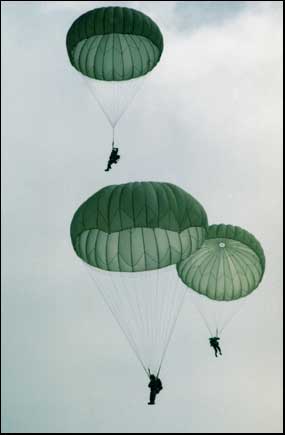
Parachutes descend over
Normandy.
Newsday Photo by Dick Kraus
|
|
We had been told that there would be a special flight of WW II
airborne veterans who had made this drop 50 years
earlier on D-Day. Now mind you, these were men who were now
in their 70’s.
They had to undergo special testing to ensure that
they were physically capable of enduring this jump.
A flight
of vintage World War II C-47’s
came into view. They were the same aircraft
that had carried these old soldiers into battle 50 years earlier.
That grew
a lump in
my throat. I watched the black dots emerge and
I thought
of how these same men had risked their lives jumping
into a strange and hostile environment so many years ago.
The vets had wanted to use the combat parachutes that were still
used by today’s airborne soldiers. But the French government
was concerned about their safety and required them to use the safer
and more reliable sport chutes that sky divers use today. So, it
was a different shape that bloomed behind each jumper. That didn’t
diminish the feeling of pride that I felt as
these old timers floated to the ground.

A WW II Vet jettisons his
tangled main chute (seen at upper left) and floats
to safety with his reserve cute.
©Newsday Photo by Dick Kraus
|
|
Suddenly,
from the crowd of spectators behind me, I heard a gasp. I
whirled around and saw them looking up and pointing skyward.
I followed their pointed fingers and saw one of the old timers
plummeting to earth with his useless parachute tangled into
a knot. It looked like certain death for this brave soldier.
But, he pulled the cord on his reserve chute. It deployed
moments before he crashed to his doom and he floated into
the crowd of cheering French men and women.
I must have been hitting my motor drive button without realizing it, because
I ended up with a decent sequence of photos. Sometimes, Argus, the many-eyed
god of Greek Mythology, looks after us poor, bewildered human photographers.
Thanks, Argus. |
And then it was June 5th, the day before the big anniversary dog
and pony show. Today, Jim and I were supposed
to go to the press tent at the American Cemetery to get our coveted White House
Press
credentials with which we could gain access to
President Clinton as he visited the various invasion beaches and memorial sites.
The trick would be getting to the cemetery to
get the cards. The
French had announced that there would be a day-long
lock down of all roads in the area on June 5th to allow them to test their security
procedures. There would be many heads of state
at the next day’s
events and the French wanted to ensure that there
would be no incidents to mar the festivities. So, we were
told that
at 5
a.m., all roads
leading to D-Day sites would be sealed unless
you had the required credentials. Unfortunately, our required
credentials
would
be at the press center, 40 miles from our hotel.
At 4 a.m., Kindall and I were on the road, heading north. The roads
were jammed with traffic trying to beat the curfew.
Jim drove and I sat next to him with road maps of the area,
trying to work our
way around traffic jams. By 5 a.m., it was growing
light and it was obvious that we would fall far short of our
destination
before the roads were sealed. Shit!! We would really
be
screwed
if we
didn’t get those all important press credentials.
And then, there it was. The first roadblock. Traffic came to
a standstill as French gendarmes and military
police turned traffic off the main road. We inched forward, hoping
to be
able to convince
the authorities ahead that we were really American
journalists trying to get our press cards. When we finally
got to
the barricaded intersection, the police didn’t even give
us the opportunity to explain our situation. With whistles
screeching from their
mouths and their hands on their guns, we were bruskly
directed off of
our intended route and onto a side road heading in
the wrong direction.
As Jim drove us down this secondary route, I checked the map
and saw that it went nowhere near the press center.
I told Jim to hang
a left at the next side street. This would take
us through the town we were in and would bring us onto a road
that
followed
the
coastline north, towards the American Cemetery.
I knew that there would be another roadblock somewhere ahead,
but
I
saw that
there
were many little farm roads indicated on the
map, that might take us around the roadblocks. Worst case scenario,
if
we got
close
enough, we could dump the car and walk up the
beach
to the cemetery to get our credentials.
Several hours passed as we wove around towns and villages and
roadblocks, getting closer and closer to our
goal. There was just one more
stretch of road left to navigate before…OH, SHIT!! Here was
another blockade. I saw traffic stalled for almost a mile and up
ahead were the gendarmes and military waving drivers away. I checked
the map and damned if we weren’t in an area where
there were no small secondary roads. There was no place
else to go,
and we
were so goddam close.
| My mind was in
turmoil and I was really frustrated. I turned to Jim and
told him to drive the car up on the shoulder of the road,
turn on his headlights, lean on the horn and gun the engine.
I leaned out of my window and waving my New York City Police
Press Card in my hand, I screamed, “JOURNALISTE! JOURNALISTE!” at
the top of my lungs. The startled gendarmes waved us through
the blockade and within minutes Kindall and I, laughing our
asses off, were picking up those magic press credentials
at the press center. |

| The New York City Police
Press Card that got us past the road block. |
|
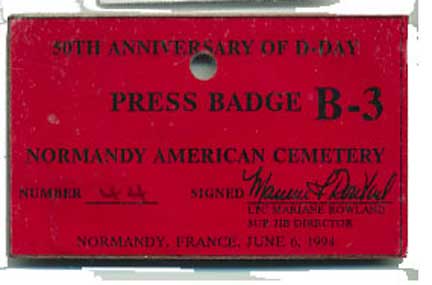
| Finally, the long awaited
D-Day Anniversary Press Card. |
|
For the
rest of the afternoon, we attended briefings detailing the timetable
for the D-Day ceremonies the
next day. The president would be attending several events, culminating
in speeches
and
the laying of wreaths at the American Cemetery
in
the afternoon. All of these would be covered by pool assignments
so I had
to sit in on several of these briefings to put
my
name in
for pool slots.
I was lucky and drew two good ones. The first
was an early morning ceremony at Pte. Du Hoc, where the American
Rangers
had
scaled
the cliffs to silence German shore batteries.
The
second was the big one at the cemetery.
Quite frankly, I didn’t need to be at any of these things.
To be blunt, my job was over. Jim and I had supplied
stories and photos for the daily paper for the past two weeks
leading
up to
this time. Our White House correspondent, who had been
traveling with Clinton, was now responsible for coverage
of the D-Day
anniversary events. She would be in the front rows with
the rest of the White
House press corp, and wire service photographers would
be in the prime positions to make photos to go with the stories.
Kindall and I were only supposed to supply sidebar accounts
of the veterans
who were in attendance.
But, like most veteran newspukes, who are like firehouse Dalmatians,
we couldn’t resist the call to action when the alarm sounded.
And so, bright and early on the morning of June 6th, 1994, I was
getting off the press bus at Pte. Du Hoc. There was a thick fog
hanging over the area and you could barely see the end of your
long lens right in front of your face. Too bad. There were great
photos to be made. There was an armada of warships standing off
shore in the English Channel, much like the morning of June 6th,
1944. In fact, Clinton had spent the night aboard the American
command ship before being airlifted by helicopter to the memorial
site. Even though I had a pool spot, it was a low-priority position.
The better spots went to the White House pool and the wire services
and big name publications. It didn’t bother me, because I
wasn’t really expected to be able to get anything
for Newsday. The low-priority media were led to a grassy
field
near the memorial
where the prez would disembark from his chopper. From
there, he would walk to the memorial to lay a wreath
and greet
the American vets who were assembled there.
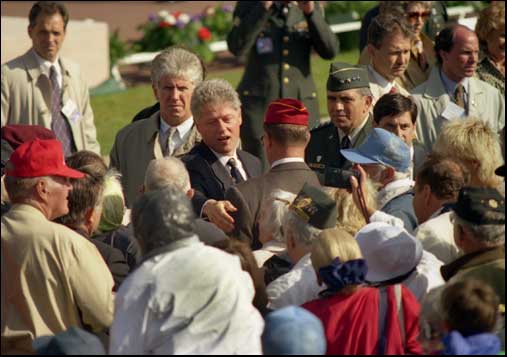
President Bill Clinton reaches
out to greet American D-Day Veterans at the Pte. du
Hoc war memorial.
©Newsday Photo by Dick Kraus
|
|
When
the chopper landed, I was in a good position to get Clinton
walking from the bird and shaking hands with the old soldiers
along his route. It made a good shot. It would have been
a great shot had we been able to see the naval ships off
shore. Too bad. Before the speeches began, a member of the
press liaison came over to us and brought us over to a position
from where we could photograph the speeches. It turned out
to be just about as good as the one being occupied by the
White House Pool. How about that? After the speeches and
wreath laying at the memorial, I got even better shots of
Clinton pressing the flesh with the vets as he headed back
to his helicopter. This time I was even closer. |
The chopper took the president to his next stop and the bus returned
the rest of us to the press center at the
cemetery. I had several hours to kill before my next pool shot
so
I found Kindall.
He had
been interviewing some of the veterans who
were waiting at the cemetery. He pointed out some of them and
I
made some
pictures
of them.
While I had some time, I decided to try to get my early shots
transmitted back to Newsday. There was no
need to go back to Caen to get my
film developed and then to my hotel to transmit.
Associated Press had set up their facilities right at
the base of
the cemetery memorial, complete with color film processors
and transmitters. I walked
over there with a pocket full of color film
and filled out the
necessary paperwork and handed off my film
to one of the
AP
techs. The place was filled with photographers
from all over the world,
doing the same thing. It would probably be
hours before they got to my film. Everyone had to take a number.
I went
outside and sat
down against a tree, waiting to be told that
my film was done so that I could select the few frames to
be transmitted.
I
was talking
with another photographer for just a few
minutes when I
heard
my name called. “Kraus! Is there a Dick Kraus
from Newsday here?”
“
Yeah. Here. What’s up?” I asked as I walked over
to him.
“
Do you have a son named Doug who was a student at the University
of California at Long Beach?” he asked.
“
Yeah,” I answered. “Why?”
“
He was my roommate.” He introduced himself and told me
to make sure I gave my film to him each time
I came in and he would
see that it got right through without waiting.
Jeez! Thanks for being my son, Doug, and for going to college
in California instead of New York.
Later that afternoon, the crowd waiting at the cemetery began
to stir. Clinton had arrived. We saw the helicopters circle
the area and settle to the ground in a field just outside the
cemetery perimeter.
I went to my pool position, which once again was a low-priority spot toward the
rear of the bleachers that had been erected. But, as before, someone came
and gathered up the White House Press pool and escorted them to another position
at ground level, just to the right of the memorial. And we were free to move
forward and occupy their former positions. |

Newsphotographers photograph
the crowd waiting to hear the president speak at the
American Cemetery.
©Newsday Photo by Dick Kraus
|
|
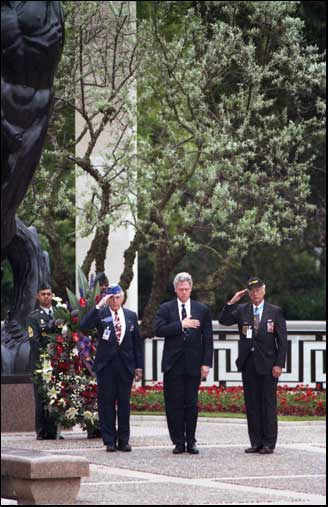
President Clinton and WW
II Veterans salute the fallen D-Day vets at the American
Cemetery,
©Newsday Photo by Dick Kraus
|
|
The morning fog
had long since burned off and the afternoon was bright and
sunny. With my 300mm lens, I was able to get tightly cropped
images as the president spoke and then laid wreaths at the
base of the memorial.
Then it was over. Clinton left to go back to Washington and I headed to the AP
facilities to look up my new friend. My film was processed and picked. AP asked
to use a couple. Since Newsday is an AP member, they had that right and in view
of the exceptional treatment I was given, I could hardly refuse.
The next day, Newsday ran my photo full Page One, of the president and two WW
II
veterans saluting the fallen soldiers of D-Day at the base of the memorial. |
It’s
things like that which makes the job and all of the required
effort and frustration so rewarding.
There was just one thing that I wanted to do before I called
it quits. I wanted to photograph Omaha Beach on June 6th, 1995,
50 years after that bloody D-Day.
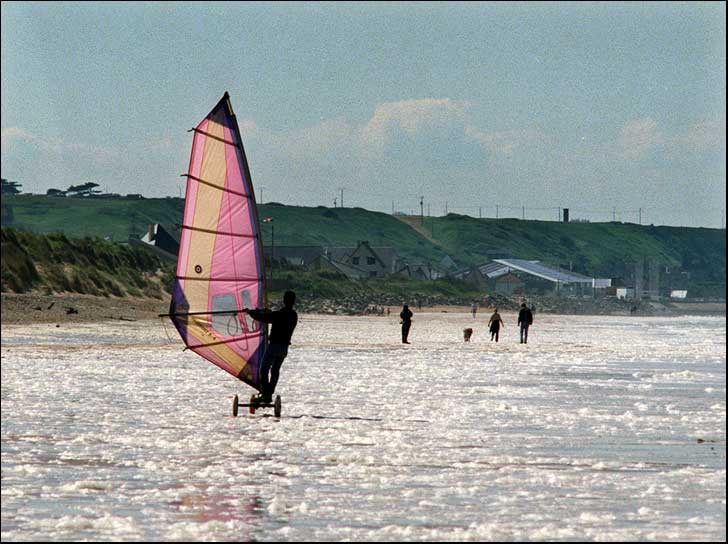
Fifty years after D-Day,
the blood and the wreckage have washed away from Omaha
Beach and the locals enjoy a more pristine and bucolic
scene.
©Newsday Photo by Dick Kraus
|
|
The next
day I flew home.
The
End
EPILOGUE.
This
story began for me in 1944 when, as a 12-year-old child,
I listened to the radio reports of the invasion. I grew
up with books and movies depicting the events of that day.
To be chosen
to go to Normandy to document that struggle and to photograph
so many of the brave men and women who participated in that epic
event was indeed a great honor for me.
I consider
this to have been the greatest assignment of my career. Thank
you for taking the time to share the occasion with me.
Dick Kraus
http://www.newsday.com
newspix@optonline.net






















